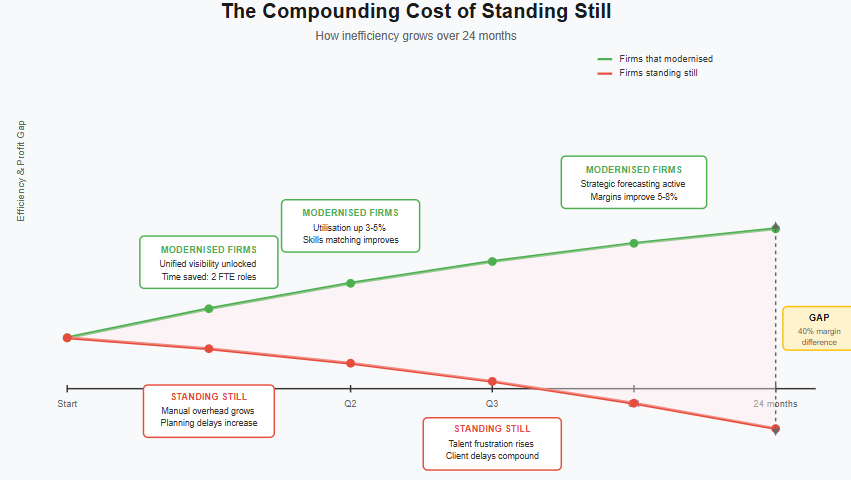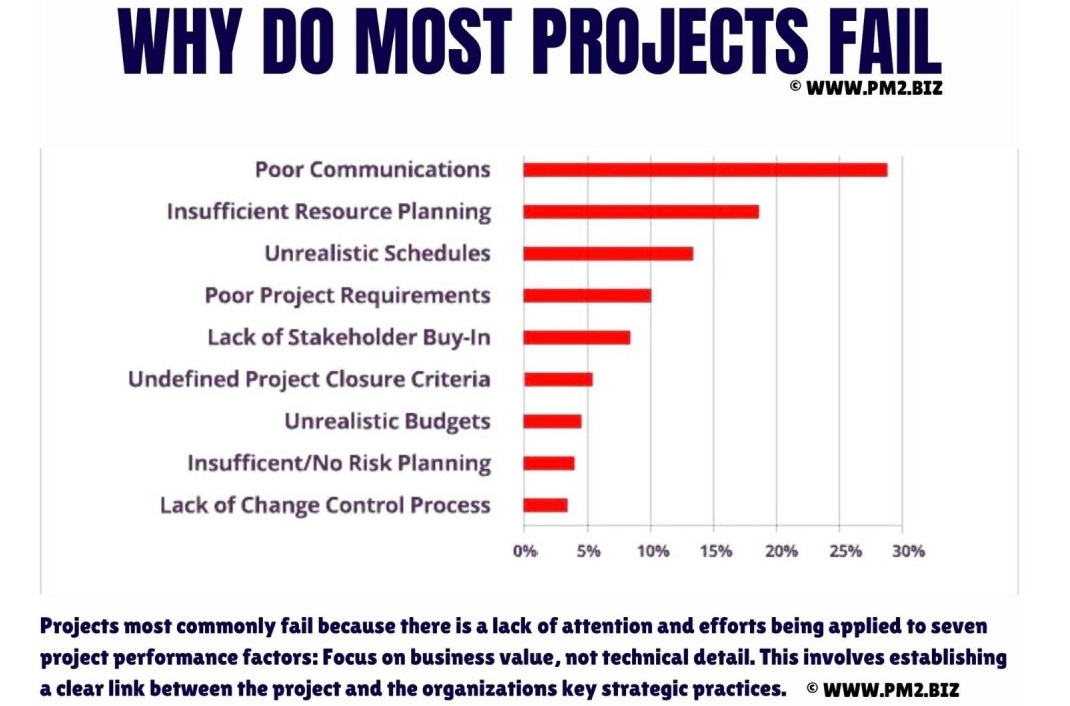Standing still can feel safe. When projects are steady and budgets tight, it’s easy to think your current resource planning setup is “good enough.” But in people based firms, waiting rarely comes without a cost.
According to the SPI Research 2025 Professional Services Maturity Benchmark, average utilisation has fallen to 68.9%, well below the 75% achieved by top firms. That six-point gap represents hundreds of billable hours per consultant each year.
Yet many firms still postpone modernising how they plan and allocate their people. Other priorities take over, and the cost of inaction compounds quietly in the background.
This guide surfaces where value is leaking today and how acting sooner can turn efficiency into advantage.
4 hidden costs of standing still with resource management
Every people-based firm feels the friction of outdated resource planning, but not every firm can see what it’s truly costing them. The impact isn’t confined to missed targets or admin inefficiencies. It cuts deeper: into profit margins, employee engagement, client satisfaction, and long-term competitiveness.
When these costs build quietly over months or years, they create a hidden drag on performance. The business still moves forward — just a little slower, a little less profitably and with more strain than it should.
Below, we’ll unpack the four areas where that drag tends to appear most often:
- #1. Financial performance – where inefficiency quietly drains margin.
- #2. People and teams – where frustration and missed potential erode engagement.
- #3. Client delivery – where reactive planning undermines trust and consistency.
- #4. Future readiness – where lack of agility limits growth and resilience.

Understanding these costs is the first step toward reducing them and building a stronger case for change.
1. The financial cost
When firms talk about improving profitability, they tend to focus on pricing or pipeline. But often, the biggest drag on margin hides in plain sight: inefficient resource planning.
Manual scheduling, disconnected spreadsheets, and slow approvals might only seem like a few extra steps (until you add them up across hundreds of projects and thousands of hours). Small gaps in visibility compound quickly.
In fact, a February 2025 report covered by TechRadar found that 90 % of organisations still rely on outdated spreadsheets for vital business data. AutoRek’s research warned that these legacy tools “pose a direct threat to operational efficiency, compliance, and competitiveness.” The familiar tools that once felt low-risk are now holding firms back.
“Legacy systems and manual processes pose a direct threat to operational efficiency. In turn, this threatens compliance and market competitiveness.”
— Nick Botha, AutoRek Payments Lead (TechRadar, Feb 2025)
For one mid-size advisory firm, replacing email-based scheduling with a unified planning platform reclaimed the equivalent of two full-time roles in lost time each quarter. Nothing changed overnight, but over months, the savings compounded.
On the other hand, there is a compounding cost of standing still:

The lesson: inefficiency doesn’t announce itself, but it always shows up in the numbers. The firms that modernise their planning first recover those hours sooner, and the financial advantage compounds from there.
2. The people cost
When visibility is poor, people feel it first. The same names get pulled into every high-pressure engagement, while others sit underused or overlooked. Over time, that imbalance drives turnover, burnout, and missed development opportunities.
According to Gallup’s 2024 State of the Global Workplace report, only 23% of employees describe themselves as engaged at work. The rest are either disengaged or actively dissatisfied — and Gallup estimates that disengaged staff cost organisations around 18% of annual salary in lost productivity (Gallup, 2024). In project-based businesses, that cost multiplies quickly.

[Image source: Gallup]
Visibility and fairness in allocation are core to engagement. Without a clear picture of skills and workload, resourcing becomes reactive: over-reliance on a few trusted individuals, under-utilisation of others, and limited recognition of growth potential. It’s a pattern that quietly drains both energy and capability.
“Employee frustration is often about a lack of opportunity,” says Kathleen Fitzgerald, resource-management specialist. “When skills aren’t visible, development stalls and the same people get stretched again and again.”
A recent LinkedIn study supports this: 94 % of employees say they would stay longer at a company that invests in their career development. Yet few firms track how project work itself contributes to skill growth, leaving on-the-job learning invisible to HR or leadership.
One audit firm addressed this by mapping project history to a skills framework. It surfaced niche expertise previously hidden in spreadsheets and cut unbalanced workloads by almost a third. The shift wasn’t about adding new processes, just making existing capability visible.
The people cost of standing still is subtle but significant: overworked teams, under-recognised talent, and a slower pipeline of future leaders. Fixing it essential for resilience.
3. The client cost
Clients notice the effects of poor resourcing long before leadership does.
Delays in confirming project teams, last-minute reshuffles, or mismatched expertise quietly erode confidence, and in competitive professional services markets, confidence is currency.
A study by the Project Management Institute found that 37% of projects fail due to a lack of clearly defined goals or misaligned skills (PMI, 2023). Similarly, a study by PM2 found insufficient resource planning to be the second most common reason, followed by unrealistic schedules and poor project requirements.

Behind these statistics are the same familiar issues: limited visibility of capability, disconnected systems, and manual processes that slow decisions. When project leads can’t see who’s certified, who’s available, or who’s worked on similar clients, matching the right expertise becomes guesswork.
The problem is, as well as increasing risk on regulated engagements, it also signals to clients that the firm isn’t fully in control.
“Clients don’t just judge deliverables; they judge responsiveness,” says Kathleen Fitzgerald. “If you can’t confirm a qualified team quickly, they assume the same lag will show up in delivery.”
A global tax advisory firm recently uncovered this firsthand. Using certification data stored across HR and compliance systems, it often took days to verify that every team member met client requirements. By centralising those records and linking them directly to planning, the firm cut onboarding time by almost a week and turned a compliance hurdle into a competitive differentiator.
When clients see well-matched teams that stay stable from pitch to delivery, they’re more likely to extend contracts and recommend the firm.
4. The opportunity cost
Every quarter spent maintaining the status quo is a quarter lost to firms that are already modernising. The gap shows up in technology, agility, foresight, and the ability to act on opportunities before others do.
The SPI Research 2025 Professional Services Maturity Benchmark found that high-maturity firms (those investing in integrated systems, data visibility, and proactive planning) achieved 40% higher profit margins and 25% faster project delivery than peers relying on manual or siloed processes (SPI Research, 2025).

Firms that still depend on spreadsheets or manual forecasting can’t see future capacity clearly enough to plan strategically. They react to demand instead of anticipating it; hiring too late, under-allocating scarce skills, or missing opportunities entirely.
“Resource planning is strategic,” notes Kathleen Fitzgerald. “When visibility improves, decision-making speeds up, and firms are ready for whatever the next quarter brings.”
A consultancy that unified its project, HR, and finance data recently gained that edge. By analysing skills and utilisation trends together, it identified a looming shortage of cybersecurity specialists three months before the busy season, and secured contract talent early. Competitors entered the same market later, paying more for the same skills.
Standing still may feel neutral, but it’s effectively moving backwards. Every month of limited visibility means slower reactions, missed bids, and less preparedness for emerging demand.
The turning point: What successful firms are doing differently
The firms moving fastest treat resource planning as a strategic capability, not a back-office task. In fact, according to the SPI Research 2025 Professional Services Maturity Benchmark, organisations with “high planning maturity” deliver 33 % higher utilisation and double the revenue growth of those still relying on disconnected tools. They’ve built habits that turn visibility into value.
Across those leaders, a few consistent patterns stand out:
- Skills over titles – They plan around capability, using structured skills frameworks to match people to the work that best fits them.
- Unified data – Finance, HR, and project systems are connected, giving decision-makers one version of the truth.
- Real-time visibility – Managers see workload, demand, and capacity in a single view, so adjustments take hours, not weeks.
- Continuous improvement – They track outcomes including utilisation, project margin, and client feedback, and use the insight to refine planning.
- Investment in people – Development is baked into scheduling, ensuring the next generation of talent grows alongside client demand.
“Modern resource planning is becoming a differentiator,” says Kathleen Fitzgerald. “The firms that invest early gain efficiency and strengthen reputation, retention, and readiness.”
And because those changes are measurable, they create the business case for continued investment, turning operational maturity into momentum.

Turning visibility into value: why acting now pays off
No firm sets out to stand still, but when the day-to-day takes over, resourcing improvements often slip down the list. The problem is, inaction leads to a steady leak of value: lost hours, untapped talent, slower decisions, and missed opportunities that compound quarter after quarter.
The firms pulling ahead are buying back time, predictability, and profit. By turning resource data into visibility, they’ve gained the clarity to plan proactively, balance workloads, and demonstrate readiness to every client that asks for it.
If you suspect your firm is already paying the hidden cost of standing still, now’s the moment to act. A clearer view of your people and projects could be the most profitable investment you make this year.
See what that could look like for your business, book a demo of Retain and uncover your firm’s potential utilisation gains.


